GHDL
TerosHDL provides comprehensive integration with GHDL (GHDL VHDL compiler and simulator), offering both configuration options and automated tasks for VHDL development. This guide explains how to use GHDL effectively within TerosHDL.
Table of Contents
- Overview
- Getting Started
- Tasks
- Understanding the Workflow
- Configuration Options
- Usage Examples
- Troubleshooting
Overview
GHDL is a free and open-source VHDL compiler and simulator. TerosHDL integrates GHDL to provide a complete VHDL development environment with:
- Syntax checking without code generation
- Analysis and compilation of VHDL files
- Elaboration of designs
- Simulation with automatic waveform generation
- Comprehensive configuration options
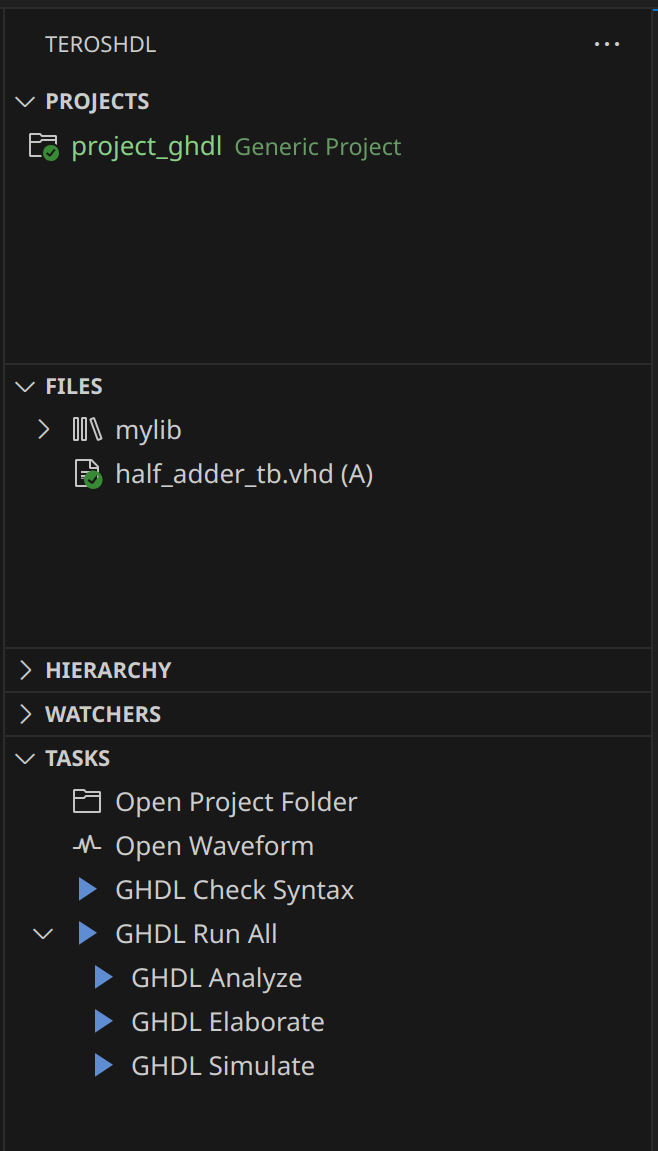
Getting Started
- Install GHDL on your system or specify the installation path in TerosHDL settings
- Create or open a VHDL project in TerosHDL
- Add your VHDL files to the project
- Specify the top-level entity for simulation
- Use the tasks to compile and simulate your design
Tasks
TerosHDL provides several GHDL tasks accessible through the Tasks panel. These tasks automate the VHDL development workflow from syntax checking to simulation.
GHDL Check Syntax
What it does: Performs fast syntax checking of your VHDL files without generating any code or updating libraries.
When to use:
- Before starting compilation to catch syntax errors early
- During development to quickly validate code changes
- When you want to check code without affecting your project libraries
How it works:
- Scans all VHDL files in your project
- Uses the VHDL standard detected from your files (or forces a specific one if configured)
- Groups files by their logical libraries
- Reports syntax errors immediately
- Does not generate any output files
Benefits:
- Fast feedback - much quicker than full compilation
- Non-invasive - doesn't modify your project libraries
- Early error detection - catch problems before simulation
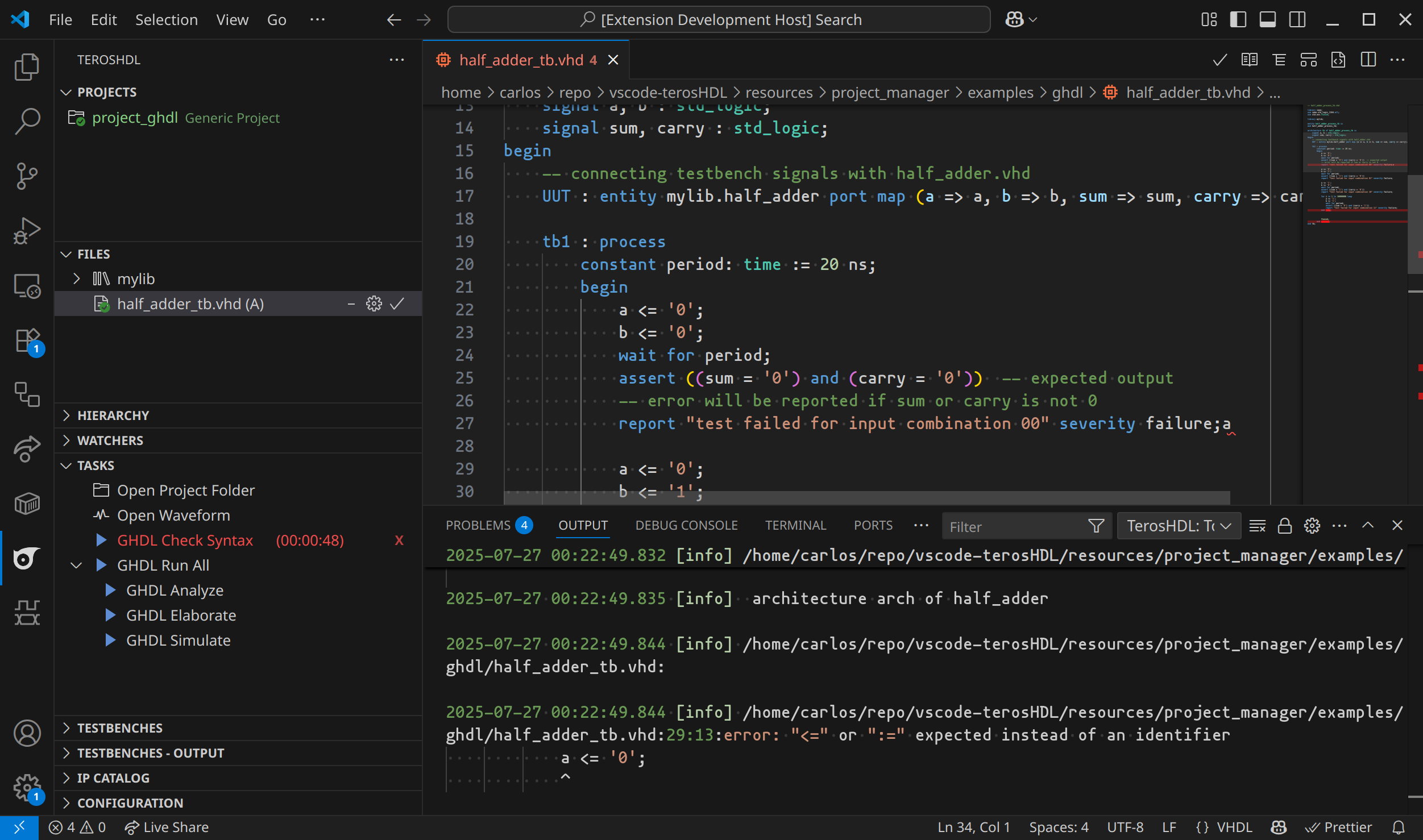
GHDL Run All
What it does: Executes the complete VHDL workflow from compilation to simulation in the correct order.
When to use:
- When you want to compile and simulate your complete design
- For final testing before deployment
- When you need waveform output for debugging
The workflow includes three sequential steps:
1. GHDL Analyze
Purpose: Compiles VHDL files and builds/updates the library database.
What happens:
- Processes files grouped by logical library
- Compiles each file and checks for errors
- Updates the library database with compiled entities, architectures, and packages
- Ensures all dependencies are properly analyzed
2. GHDL Elaborate
Purpose: Links the design and prepares it for simulation.
What happens:
- Takes your top-level entity and traces all its dependencies
- Resolves all component instantiations and port mappings
- Creates an executable simulation model
- Performs binding checks and optimizations
3. GHDL Simulate
Purpose: Runs the actual simulation and generates results.
What happens:
- Automatically removes old waveform files (
wave.*) to ensure clean results - Executes the simulation with your configured time limits
- Generates waveform files in your chosen format (VCD, GHW, or FST)
- Applies all run-time options and signal tracing
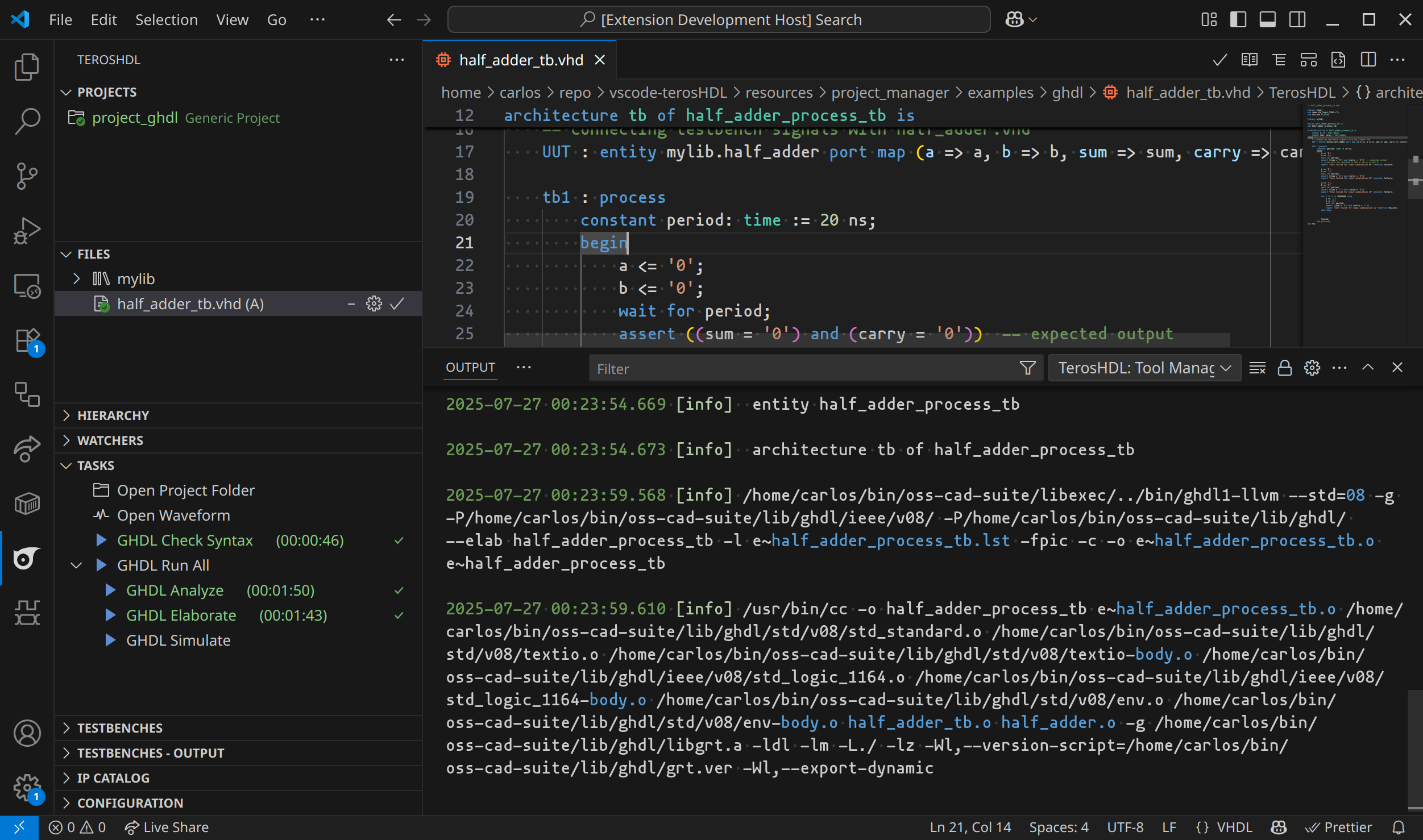
Individual Tasks
You can also run the components of "GHDL Run All" individually:
GHDL Analyze (Standalone)
Run only the analysis/compilation step. Useful when:
- You want to check compilation without simulation
- You're working on library packages that other files depend on
- You need to update libraries after code changes
GHDL Elaborate (Standalone)
Run only the elaboration step. Useful when:
- Analysis is already complete
- You want to test design binding without simulation
- You're debugging elaboration-specific issues
GHDL Simulate (Standalone)
Run only the simulation step. Useful when:
- Analysis and elaboration are already complete
- You want to re-run simulation with different parameters
- You're experimenting with different simulation settings
Open Waveform
Purpose: Opens the generated waveform files in your configured viewer.
What it does:
- Searches for waveform files (
.vcd,.ghw,.fst) in the project directory - Opens the found waveform files using your configured viewer
- Provides easy access to simulation results
When to use:
- After running a simulation to view waveform results
- To re-open waveform files from previous simulations
- When you want to analyze timing and signal behavior
Supported viewers:
- GTKWave - External professional waveform viewer
- VaporView - VS Code extension for waveform viewing
- Built-in tool viewers - When available
Supported formats: GHW, VCD, FST
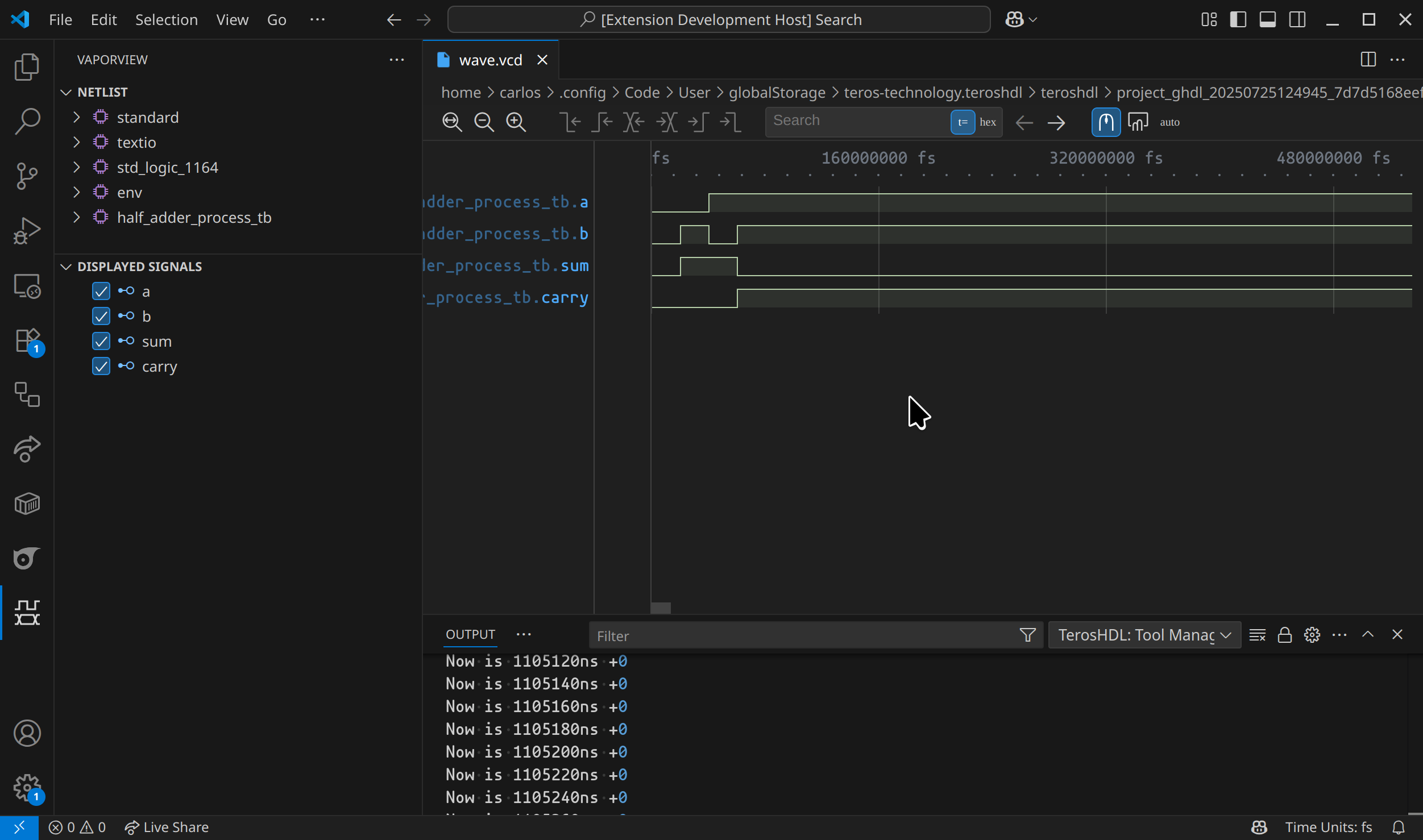
Understanding the Workflow
The VHDL Development Cycle
1. Write/Edit VHDL Code
↓
2. Check Syntax (optional but recommended)
↓
3. Analyze → Elaborate → Simulate
↓
4. View Waveforms
↓
5. Debug and Iterate
When to Use Each Task
| Task | Use Case | Speed | Output |
|---|---|---|---|
| Check Syntax | Quick validation during development | Very Fast | Error reports only |
| Analyze | After code changes, library updates | Fast | Updated libraries |
| Elaborate | Test design binding and connectivity | Fast | Simulation model |
| Simulate | Generate results and waveforms | Moderate | Waveforms, logs |
| Run All | Complete workflow, final testing | Full time | Complete results |
| c |
Configuration Options
All GHDL settings are accessible through TerosHDL's configuration interface.
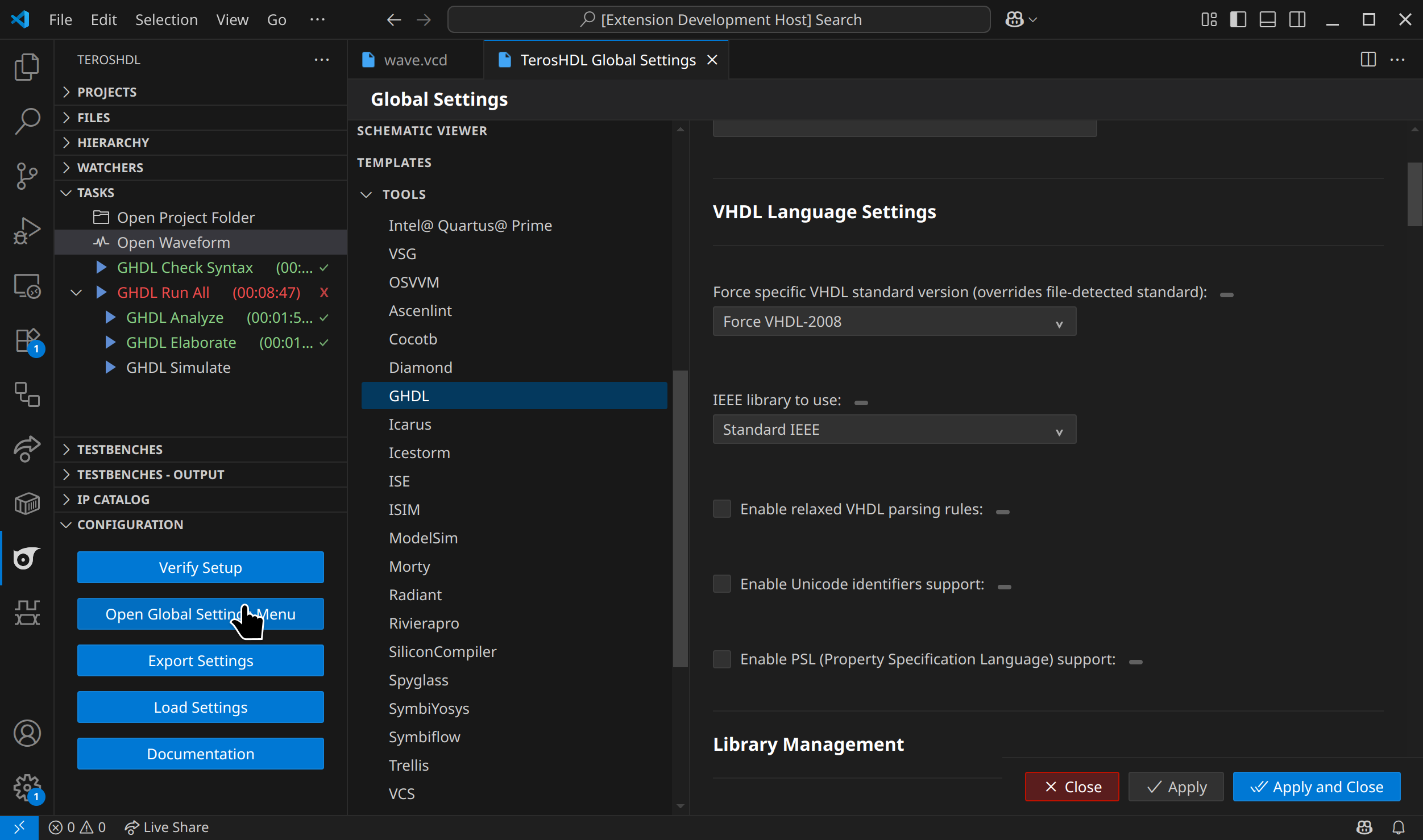
Basic Configuration
Installation Path: Specify where GHDL is installed on your system
- Leave empty to use system PATH
- Required if GHDL is not in your system PATH
VHDL Language Settings
VHDL Standard Version: Control which VHDL standard to use
Auto-detect from file: Automatically detect from your VHDL files (recommended)Force VHDL-87/93/2002/2008/2019: Override with specific standard
IEEE Library: Choose IEEE library implementation
Standard IEEE: Standard IEEE implementationSynopsys IEEE: Synopsys IEEE implementation
Relaxed Parsing: Enable more lenient VHDL parsing rules
Unicode Support: Allow Unicode identifiers in your VHDL code
PSL Support: Enable Property Specification Language features
Library Management
Work Library: Name of the default working library (usually "work")
Library Paths: Additional directories to search for VHDL libraries
Stage-Specific Options
Check Syntax Options: Additional flags for syntax checking (ghdl -s)
Analyze Options: Extra options for compilation (ghdl -a)
Elaborate Options: Additional flags for elaboration (ghdl -e)
Run Options: Simulation parameters (ghdl -r)
Synthesis Options: Options for synthesis (ghdl --synth)
Simulation Settings
Simulation Time: Set maximum simulation time (e.g., "1ms", "500ns")
Resolution Limit: Set time precision (e.g., "1ps", "1ns")
Stack Size: Memory allocation for simulation
Stop Delta Cycles: Limit delta cycle iterations
Waveform Output
Waveform Enabled: Enable/disable waveform generation
Waveform Format: Choose output format
VCD: Value Change Dump (widely supported)GHW: GHDL native format (most detailed)FST: Fast Signal Database (compact)
Waveform Options: Additional waveform generation parameters
Advanced Waveform Settings:
- Wave start time recording
- VCD 4-state format
- Signal filtering options
- Custom wave option files
Debug and Analysis
Debug Level: Control amount of debug information
No debug info: Fastest executionMinimal debug info: Basic informationFull debug info: Detailed debugging
Verbose Output: Enable detailed command output
Error and Warning Handling
Warnings as Errors: Treat warnings as compilation errors
Suppress Warnings: Specify warning types to ignore
Assertions and Verification
Assert Level: Control assertion sensitivity
Note/Warning/Error/Failure level: Different sensitivity levelsDisable assertions: Turn off assertion checking
Display Options: Show timing and delta cycle information
Backtrace Settings: Control error backtrace generation
IEEE Standards Compliance
IEEE Asserts: Control IEEE assertion handling
Asserts Policy: Policy for handling assertions during simulation
Advanced Features
File I/O and External Interfaces:
- SDF file support for timing annotation
- VPI/VHPI module loading
- External trace file generation
- PSL reporting options
Display and Hierarchy:
- Design hierarchy display options
- Signal and port visualization
- Process and instance information
Usage Examples
Basic Workflow Example
-
Setup your project:
- Ensure GHDL is installed and configured
- Add your VHDL files to the project
- Set the top-level entity
-
Quick syntax check:
- Run "GHDL Check Syntax" to catch any syntax errors
- Fix any reported issues
-
Full simulation:
- Run "GHDL Run All" to compile and simulate
- Wait for completion (monitor progress in Tasks panel)
-
View results:
- Click "Open Waveform" to view simulation results
- Analyze signals and timing in the waveform viewer
Troubleshooting
Common Issues and Solutions
GHDL Not Found
Problem: Error message "ghdl: command not found" Solutions:
- Install GHDL on your system
- Add GHDL to your system PATH
- Set the correct installation path in TerosHDL configuration
No Top-Level Entity
Problem: "No top level entity specified" Solutions:
- Specify the top-level entity in your project settings
- Ensure the entity name exactly matches your VHDL file
- Check that the entity is properly declared
Compilation Errors
Problem: Analysis or elaboration fails Solutions:
- Run "GHDL Check Syntax" first to identify syntax issues
- Verify VHDL standard settings match your code
- Check library dependencies and include paths
No Waveform Generated
Problem: Simulation completes but no waveform file appears Solutions:
- Enable "Waveform Enabled" in configuration
- Check "Run Options" for waveform generation parameters
- Verify simulation actually ran (check for error messages)
- Ensure you have write permissions in the project directory
Library Issues
Problem: "Library not found" errors Solutions:
- Check library path configuration
- Verify library directory structure
- Ensure all required libraries are properly compiled
- Check file library assignments
Performance Tips
- Use syntax checking during development to catch errors early
- Enable appropriate debug level (minimal for faster execution)
- Set reasonable simulation time limits for large designs
- Use efficient waveform formats (FST for large simulations)
- Organize libraries efficiently to minimize compilation time
Getting Help
- Check the terminal output for detailed error messages and warnings
- Use verbose mode for more diagnostic information
- Start with simple examples to verify your setup
- Check GHDL documentation for command-line option details